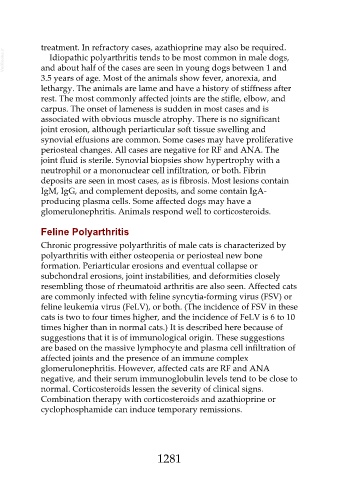Page 1281 - Veterinary Immunology, 10th Edition
P. 1281
treatment. In refractory cases, azathioprine may also be required.
VetBooks.ir and about half of the cases are seen in young dogs between 1 and
Idiopathic polyarthritis tends to be most common in male dogs,
3.5 years of age. Most of the animals show fever, anorexia, and
lethargy. The animals are lame and have a history of stiffness after
rest. The most commonly affected joints are the stifle, elbow, and
carpus. The onset of lameness is sudden in most cases and is
associated with obvious muscle atrophy. There is no significant
joint erosion, although periarticular soft tissue swelling and
synovial effusions are common. Some cases may have proliferative
periosteal changes. All cases are negative for RF and ANA. The
joint fluid is sterile. Synovial biopsies show hypertrophy with a
neutrophil or a mononuclear cell infiltration, or both. Fibrin
deposits are seen in most cases, as is fibrosis. Most lesions contain
IgM, IgG, and complement deposits, and some contain IgA-
producing plasma cells. Some affected dogs may have a
glomerulonephritis. Animals respond well to corticosteroids.
Feline Polyarthritis
Chronic progressive polyarthritis of male cats is characterized by
polyarthritis with either osteopenia or periosteal new bone
formation. Periarticular erosions and eventual collapse or
subchondral erosions, joint instabilities, and deformities closely
resembling those of rheumatoid arthritis are also seen. Affected cats
are commonly infected with feline syncytia-forming virus (FSV) or
feline leukemia virus (FeLV), or both. (The incidence of FSV in these
cats is two to four times higher, and the incidence of FeLV is 6 to 10
times higher than in normal cats.) It is described here because of
suggestions that it is of immunological origin. These suggestions
are based on the massive lymphocyte and plasma cell infiltration of
affected joints and the presence of an immune complex
glomerulonephritis. However, affected cats are RF and ANA
negative, and their serum immunoglobulin levels tend to be close to
normal. Corticosteroids lessen the severity of clinical signs.
Combination therapy with corticosteroids and azathioprine or
cyclophosphamide can induce temporary remissions.
1281

